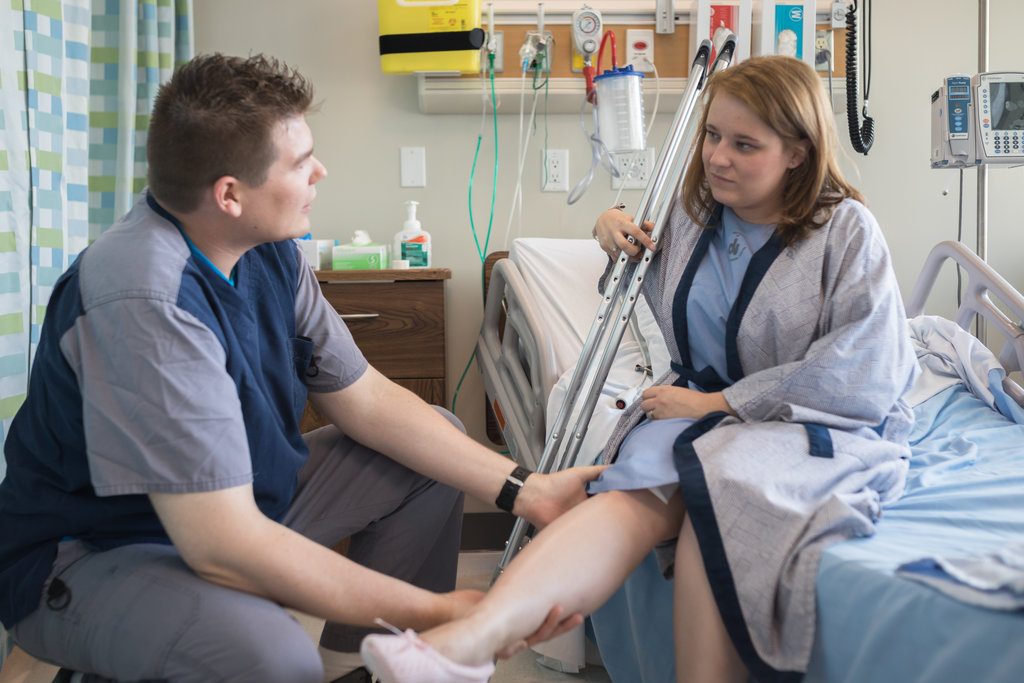In an Edmonton hospital’s surgical unit, a licensed practical nurse (LPN) named Brett Funk watched a colleague he was mentoring fail an attempt to start a patient’s IV.

As the patient shifted uncomfortably, Funk pulled out his iPad and loaded a medical education app called 3D4Medical. He showed a detailed image of a vein to the patient and explained what happened, why an issue occurred and how a nurse could avoid the problem in the future.
“The patient was very intrigued, and it definitely helped relax them for when I did the IV,” Funk says. “It gave us something to talk about as well… Their mind was not on the pain but on the information I was sharing.”
This is just one example of how Funk and his fellow LPNs use technology to provide Albertans with patient-centred care, a model designed to empower patients to be active participants in their treatment plan.
It’s a philosophy based on good communication between medical professionals, patients and their loved ones, and relies on care providers being patient advocates.
Research shows that this model leads to higher patient satisfaction, a greater likelihood of following treatment plans, better outcomes and cost savings for the medical system.
“Ultimately, [it] benefits society because we have the ability to positively influence patients and help them lead healthier lives,” Funk says.
Some of the key principles of patient-centred care are respect for patients’ preferences, coordination and integration of care, information and education, physical comfort and involvement of friends and family.
In addition to 3D4Medical, Funk and his colleagues use Vax, an electronic database of patient information. The program helps with everything from coordinating diagnostic tests and arranging surgery times to adjusting patient diets and tracking their allergies.
“This helps us communicate more effectively behind the scenes, which then contributes to safety and a better patient experience,” Funk says.
“No single medical professional can handle every aspect of a patient’s health. We have all sorts of different specialties, and by consulting with each other, we can provide that patient-centred experience.”
Technology also comes into play when LPNs strive to provide patients with the most comfortable experience possible. In the pre-op area, for example, they use a machine called the Bair Hugger, which blows hot air over the patient’s body through a special warming blanket.
The purpose of the machine is to help reduce the risk of blood clots and infections during surgery, but it also helps patients relax and stay cozy in the chilly hospital.
Using technology to provide patient-centred care starts in the classroom.
At NorQuest College in Edmonton, licensed practical nursing students work on high-fidelity mannequins and experience real-life scenarios through virtual reality.
The lifelike mannequins are given names, medical histories, and have their own blood pressure, pulse and respirations, which an instructor controls from a laptop.
“The students get to interact as if it was a client, and they can really immerse themselves into that scenario,” says Violet Page, a licensed practical nurse and educator. “It encourages critical thinking and the development of clinical judgement, and teaches them about complex situations.”
NorQuest also recently started using virtual reality. Students can put on a VR headset and be immediately transported to a hospital or clinic to practice their skills.
“Technology helps students feel more prepared when they go out,” Page says.
LPNs are educated to provide the highest competency in caring for all Albertans. Working as an integral part of healthcare teams in varied settings from emergency departments to pediatrics, LPNs deliver competent, committed care never losing sight of a person-centred approach that encourages well-being and health for all Albertans. Learn more here.



